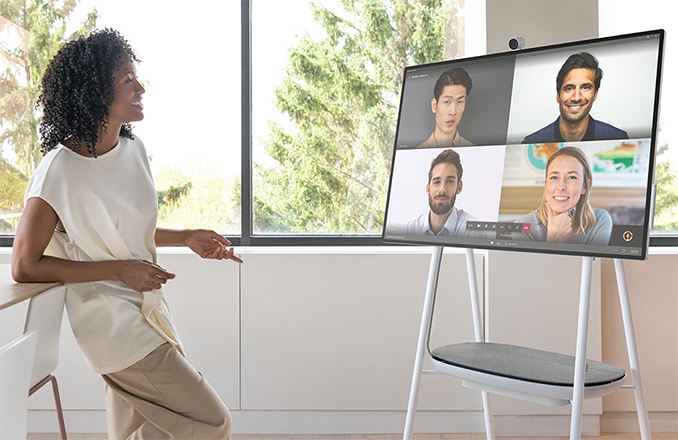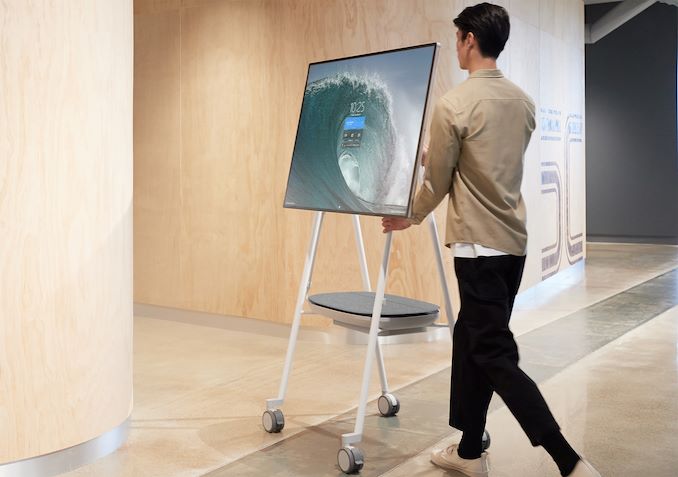Microsoft Announces Surface Hub 2S: 50-Inch for $9000
by Anton Shilov on April 18, 2019 2:00 PM EST- Posted in
- Systems
- Microsoft
- Surface
- Surface Hub
- Surface Hub 2S

Microsoft has introduced its new family of Surface Hub collaboration devices designed for conference rooms. The new lineup includes an all-new 85-inch model for those who need larger screens as well as an all-new 50-inch model that can be powered by a battery. What is interesting is that the new collaborative PCs are upgradeable, unlike the first-gen Surface Hubs launched in 2015.
The Microsoft Surface Hubs are fully-fledged all-in-one PCs with software and hardware capabilities tailored for collaboration and conference rooms. The Surface Hub 2S 50-inch features a 3840x2560 resolution, is based on Intel’s 8th Gen quad-core Core i5 processor with Intel’s UHD 620 graphics that is accompanied by 8 GB of RAM as well as a 128 GB SSD. Being a system from Microsoft, the Surface Hub 2S comes pre-loaded with a special version of Windows 10, Skype for Business, Microsoft Whiteboard, Microsoft Office, and other programs. Obviously, the PCs are equipped with a standard set of ports, including GbE, USB Type-A, USB Type-C, HDMI, etc.
One of the key differences between the Surface Hub 2S and its predecessors is the fact that its compute hardware is no longer built-in, but comes inside an upgradeable cartridge. For example, next year Microsoft plans to release its Surface Hub 2X processor cartridge offering higher GPU performance along with a set of new software capabilities.
The new Surface Hub 2S collaborative PCs come with the Surface Hub 2 camera as well as the Surface Hub 2 Pen. In addition, Microsoft will offer specially designed stands and wall mounts as well as an APC-designed battery for the 50-inch model.
Microsoft will start selling its Surface Hub 2S 50-inch this June at a price of $8,999. The larger 85-inch model will be available in 2020.












19 Comments
View All Comments
Freakie - Thursday, April 18, 2019 - link
Cartridge idea is very nice. If the screen has 10-bit color then releasing a cartridge with Quadro or Radeon Pro would entice design/marketing departments to buy these so that they could use them to collaborate and present in the color spaces they edit and print in.Freakie - Thursday, April 18, 2019 - link
Found the tech specs online, and it does have a 10-bit panel. But seeing as Microsoft doesn't put professional GPUs in their Surface Studio which they market as a "creative" device and therefor programs like Photoshop can't show wide-color gamut, I doubt Microsoft has the brains to offer a cartridge with one either.hybrid2d4x4 - Thursday, April 18, 2019 - link
Wow, $9000 and it only comes with 128GB SSD (worth what? $30@OEM pricing?)What an embarrassment! It looks bad on a $1000+ laptop, but this is a brand new low...
Drumsticks - Thursday, April 18, 2019 - link
This is a conferencing tool with a PC, not a tool for video calling on facebook. If memory serves, the competition here (conferencing tools for meeting rooms/collaboration) are quite a bit more expensive.Zizy - Thursday, April 18, 2019 - link
MS would lose what, 100$ by offering a 1TB SSD (street price of 1TB of the cheapest M2 SSD - Intel's 660p). By that upgrade, the only "oh, that is low" spec would look much better.As for utility, it wouldn't hurt to install programs to demo stuff during meetings - to avoid messing with remote desktop.
jordanclock - Thursday, April 18, 2019 - link
How much storage do you think a conferencing display needs? Nothing is going to be coming from the local storage except the apps. It could come with 64GB of SSD storage and no one would notice a difference.hybrid2d4x4 - Monday, April 22, 2019 - link
I disagree. Any pc that runs Win10 will completely fill a 64gb drive with just two of the (semi?-)annual major updates for the OS with zero user apps installed unless the user runs the drive cleanup after every update and even then the free space will shrink down into nothing within a few years due to gradual OS and app bloat. Case in point: my work computer only has a handful of apps installed with the big ones being MS Office and Autodesk Civil3D and yet the Windows folder is sitting at 52.6GB right now, Users @ 23.3GB, Prog files @13.6GB, Prog (x86)@13.6GB. Then there's swap file/hibernation/etc. And this is all on a Win 7 install that's 4 yrs old. It started out at ~30GB all-in. Anecdotally, on my Win10 install at home, it's a lot more aggressive with installing updates and unwanted garbage apps (Candy Crush,etc.) by default. 1TB is probably overkill, but I think 256GB should be the minimum even if you don't intent to use that storage but plan on getting >5yrs of use out of that machine.Kevin G - Monday, April 22, 2019 - link
That depends on how they sync content between the account for the display and end users. I've seen some weird stuff happen were the display will try to pull an entire directory then sync it back. It had a couple of video files worth a few GB. Point is that the storage can be touched. I would consider 128 GB on the small size but 256 GB or 512 GB would be more than enough.skavi - Thursday, April 18, 2019 - link
what you are paying for here is the custom, low volume, high quality display and the custom software Microsoft has made for this platform. Not the PC inside.CheapSushi - Friday, April 19, 2019 - link
Can you describe in detail why this conference display would need a 1TB drive, for example?